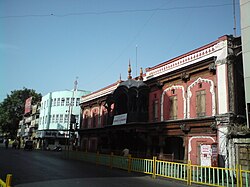Wada (house)
A wada (Marathi) or wade (Kannada)[1][2][3] is a traditional mansion house form usually found in North Karnataka and Maharashtra.[4][5] Wadas were the epicentres of administration in North Karnataka and of Maharashtra.[4]
Origin[edit | edit source]
The origin of wades traces back to Adil Shahi dynasty of Bijapur. They evolved during their reign and flourished till the end of British rule[4]
Wades in North Karnataka[edit | edit source]
wades are meant for residential purpose and administrative purpose. uniqueness of North Karnataka wades is, have constructed within a small fort with watch towers. and every wade have its own fortress. wades are out of cortyard structure. and small temples installed in the fort of wades.
Wadas in Maharashtra[edit | edit source]
wadas in Maharashtra are constructed with cortyard. these wadas are free of forts. only the shaniwar wada is constructed with fort.
Significance[edit | edit source]
Wadas became residential manors of the kings or humble commoners in the eighteenth and nineteenth century in Maharashtra under Peshwa rule (Batley 1934, Shastri 1970, Kanhere 1982).[6]
See also[edit | edit source]
Gadhi — a castle-like structure (also called a “Big Wada”)
References[edit | edit source]
- ↑ "ದೇಸಾಯರ ವಾಡೆ ಇದಕ್ಕುಂಟು ನೂರಾರು ವರ್ಷಗಳ ಇತಿಹಾಸ". Udayavani - ಉದಯವಾಣಿ. Retrieved 11 November 2019.
- ↑ "ಗಡಿಭಾಗದ-ವಾಡೆ-ನೋಡಿರಿ-ಈ-ಕಡೆ". Prajavani. Retrieved 11 November 2019.
- ↑ "ಕೆರಕಲಮಟ್ಟಿ ವಾಡೆ - Udayavani2". Dailyhunt. Retrieved 11 November 2019.
- ↑ 4.0 4.1 4.2 "Wade Tradition, Kavi Pampa and Jain Connections". Jain Heritage Centres. 23 October 2014. Retrieved 11 November 2019.
- ↑ Agashe, Saurabh (2 August 2019). "Venerable trees and a gothic market: heritage-hunting in fast-changing Pune". The Guardian. Retrieved 11 November 2019.
- ↑ Desāī, Mādhavī; Desai, Madhavi; Desai, Miki; Lang, Jon (2012). The Bungalow in Twentieth-Century India: The Cultural Expression of Changing Ways of Life and Aspirations in the Domestic Architecture of Colonial and Post-colonial Society. Ashgate Publishing, Ltd. ISBN 9781409427384. Retrieved 11 November 2019.
External links[edit | edit source]
